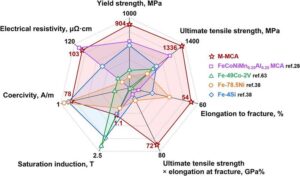

Making soft magnetic materials more ductil and stronger through nanoparticles
Credit: Tianyi You, Max-Planck-Institut für Eisenforschung GmbH
Researchers use multicomponent alloys to make strong and ductile soft magnetic materials. Latest results now published in the journal Nature.
Soft magnetic materials (SMMs) applied in electric engines transform energy from sustainable resources into electricity. Conventional SMMs, which are currently used in industry, are prone to damage under severe mechanical loads. Researchers from the Max-Planck-Institut für Eisenforschung (MPIE), the Technical University of Darmstadt and the Central South University, China, have developed a new design strategy that increases the lifetime of SMMs and paves the way for advanced applications like high-speed motors. They published their recent findings in the journal Nature.
Introducing nanoparticles for increase in strength and ductility

Comparison of the mechanical and functional property spectra of the new multicomponent alloy.
(c) Nature
“The current problem we are facing in conventional soft magnetic materials is the trade-off between being magnetic soft on the one hand, and mechanically strong on the other hand”, explains Liuliu Han, doctoral researcher at the MPIE and first author of the publication. Higher strength in materials is usually achieved through the implementation of microstructural features such as precipitations and defects. According to the state of the art, introducing these nanoparticles into soft magnetic materials will pin the movement of the domain walls thus decrease the magnetising force. The scientists discovered that the size of the nanoparticles plays a crucial role for both, the mechanical strength and ductility of the magnets and their magnetism. “Till now it was assumed that smaller nanoparticles interact less with the domain walls and are therefore preferred. However, quite the opposite is true. We implemented particles that are slightly below the domain wall width. This coarsening means a smaller specific surface area and reduced the internal stress level so that the magnetic properties were not affected”, says Han.
Multicomponent alloy system for advanced soft magnets
The researcher team realized this design idea in a multicomponent alloy system, derived from the high entropy alloy concept, containing iron, nickel, cobalt, tantalum and aluminium with multifunctional properties, which is not common for conventional soft magnets targeting soft magnetic properties mainly. In addition, materials based on the new alloy system are easier to manufacture and have a higher lifetime than the conventional magnetic materials. “With the help of computational calculations and machine learning, we are now trying to find ways to reduce the cost of the proposed alloy by reducing the amount of the containing expensive elements, such as cobalt, and by finding substitutes with similar properties”, says Dr. Fernando Maccari, postdoctoral researcher in the Functional Materials group at TU Darmstadt and second author of the publication. Magnetic properties were investigated at TU Darmstadt, whereas the design of the composition and the characterization of the alloy was done at the MPIE.
The alloy composition used here serves as a model system for multicomponent alloys. The concept of using multicomponent alloys is not limited to soft magnetic materials, but is applicable for advanced alloys with new and unusual combinations of functional and mechanical properties.
Wissenschaftliche Ansprechpartner:
Dr. Liuliu Han, l.han@mpie.de
Originalpublikation:
https://www.nature.com/articles/s41586-022-04935-3














